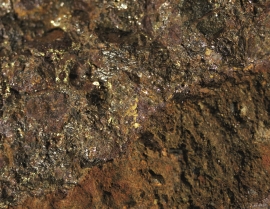Published: 07.08.2015 | Author: Haakon Fossen, Nils Georg Brekke
HOSANGER NICKEL MINE
Large quantities of nickel ore have been mined from Litlandsvatnet, between Lonevågen and Hosanger. The discovery was made in 1875. During the period of operation from 1882 to 1945, 4170 tonnes of pure nickel were extracted from 462 000 tonnes of ore, a large production by Norwegian standards.
The ore contained between 0.4 and 3.0% nickel. The ore lay on the underside of a gabbro. The gabbro lay like a giant lens in the quartz-rich gneisses that dominate in the area. It is believed that, a billion years ago, when the gabbro was flowing magma, it intruded into the gneisses. Sulphide minerals, such as for example pentlandite that contains nickel, in addition to pyrrhotite, chalcopyrite and pyrite, were among the first minerals that were formed when the magma gradually began to cool. They sank down to the bottom of the magma and were thereby lying at the bottom of the gabbro.
The lack of profitable ore caused the mine to close in 1945. But, there are still many signs of its operations, and the ore is still visible by the mine shaft at Lake Litlandsvatnet.
The ore, which can be found above the mine buildings, is rusty on the outside. A well-directed strike with the hammer reveals its original appearance. (Haakon Fossen)
Mining on Osterøy
In 1875 finds of stone containing iron ore were made at Litland and Nonås, and in 1882 an English company started mining at Nonås. In the first years the iron ore was carried in baskets from Nonås to Gjetreim, to the export harbour. Later on a road and a quay were built. A Swedish company took over the operations in 1890 and built Norway’s first cable car from Nonås to Gjetreim. In 1915 Kristiansand Bikkelraffineringsverk established a modern mining facility at Litland, with a cable car from Litland to Bysheim quay. After a bankruptcy in 1920 the operations were again started in 1933, but it came to an end in 1945. By then 500,000 tons of iron ore stone had been mined, which yielded 5,000 tons of pure nickel. Two of the old mines at Nonås are accessible today, and the mining area at Litland is visible from the highway.
The limestone mines at Skaftå at Bruvik were also started in the 1870s, and for almost 100 years, until 1961, this was a major place of employment, with a workforce of around 40-50 men. The industry was first started by P.G.Rieber,who first extracted marble blocks for his workshop in Bergen. The surplus stone went to his limekiln business. From 1908 most of the stone went to the limekiln at Odda melting plant, for carbide and fertiliser production. The lime vein in the mountains stood vertically at a width of 12 metres, and the mine was roughly one kilometre long. Altogether around 4 million tons of limestone was taken out here. The open cast mining cuts are still visible, 150 m from the road.
- Bjørlykke, H. 1949. Hosanger nikkelgruve. Norges Geologiske Undersøkelse 172:1–38





